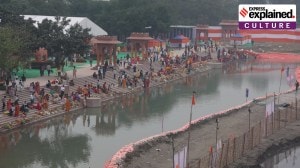PC pioneer Osborne dies an obscure death in Kodaikanal
His name signifies a milestone in computer revolution in the Silicon Valley. The first 24-pound portable computer he invented in 1981, which...

His name signifies a milestone in computer revolution in the Silicon Valley. The first 24-pound portable computer he invented in 1981, which went on to bear his name as Osborne 1, now adorns the Smithsonian museum in Washington.
But in the silent valley of Kodaikanal, where Adam Osborne was to spend nearly a decade far away from computers and breathe his last on March 18 at the age of 64, he was just the Vellaikara Tamizhan (White Tamil).
|
Osborne 1, now a museum exhibit. Courtesy: Erik S Klein
|
Osborne, who ‘‘renounced’’ the world of computers and settled here in 1992, died in his sleep 12 days ago. His was a riches-to-rags story, a man who became a billionaire and then bankrupt in just two years.
Not many in Kodaikanal hills knew him to be the creator of the portable computer. His residence in Prakashapuram does not bear any testimony to the micro-computer revolution the technical writer, business executive and computer pioneer had launched.
But in Silicon Valley, few are unaware of it. According to The Washington Post, Osborne — who learned to programme a computer while studying at University of Delaware in the ’60s — introduced his computer in June 1981 at the West Coast Computer Fair. Selling at $1,795, weighing 24 pounds and about the size of a sewing machine, Osborne 1 was designed to be light enough to carry as luggage and compact enough to fit under a commercial airline seat. Osborne called his computer ‘‘adequate’’, maintaining that it provided ‘‘90 per cent of what most people need’’. The computer came bundled with nearly $1,800 worth of software, including Microsoft Basic, the SuperCalc spreadsheet and the WordStar word processing programme.
Osborne 1 flew off the shelves, taking Osborne Computer Corp of Hayward, California, to great heights. However, the end was equally fast, in a way that mirrored later Silicon Valley ventures. Washington Post says the company had sales of $5.8 million in 1981, $68.8 million in 1982, and had declared bankruptcy in 1983.
Many blamed it on Osborne’s enthusiasm for the personal computer. He trumpeted a next-generation computer, the Vixen, much advanced to Osborne I. Buyers kept waiting for the new computer that never arrived, and sales of Osborne I ground to a halt. Since then, a company’s announcement of plans for a new product that results in a plummeting of sales in the old product is referred to as the ‘Osborne Effect’.
Friends and associates in Kodaikanal say in the past 10 years, Osborne hardly ever talked about computers.
The former caretaker of the pioneer’s house in Kodaikanal, Suresh Antony, recalls he would become tense whenever the subject was broached. ‘‘Master used to hear news, watch cricket and see the National Geographic and cartoon channels. Occasionally, he would talk about computers.’’
Dr Pathmanathan, his family doctor, found the reticence surprising, and points out that while Osborne had a cerebral stroke and was affected by Parkinson’s disease, his faculties were intact till about two years ago.
Confining himself to Kodaikanal and Tiruvannamalai, Osborne led a peaceful life. ‘‘A man of few words, he did not have many complaints,’’ says his friend Christopher.
The son of a Polish mother and English father, Osborne had strong roots in Kodaikanal. He had his early schooling in the Presentation Convent at the hill station.
He grew up in the Ramana Maharishi ashram in Tiruvannamalai and was interested in Eastern philosophy. He was also well-versed in Tamil. ‘‘He would always have by his side a picture of Ramana Maharishi,’’ Christopher says.
His father, Arthur Osborne, was a journalist and also authored a number of books on Ramana Maharishi. Osborne’s sister, Katya Douglas, who still lives here, says: ‘‘There is no history of computer interest among us, but one could say the urge to write runs through the family.’’
Osborne himself authored six books, including his memoir Hypergrowth, that is a story of his company and a textbook study of the perils of undisciplined growth.
According to Post, in 1984, he founded Paperback Software, a venture to publish software programmes. The company failed after its spreadsheet programme was found to infringe on the Lotus 1-2-3 system. In 1992, Osborne started his last venture, Noetics Software, to explore cutting-edge topics such as neural networks and their application to computer programming. Later in 1992, he retired to India.
In 1988, NIIT had sponsored a series of special lectures all over the country by Osborne on the ‘Strategic impact of personal computers on organisations and world trends in hardware and software’. Showing he still hadn’t lost his humorous side, Osborne centred his entrepreneurship speeches on ‘How I won and lost a billion dollars’.



- 01
- 02
- 03
- 04
- 05




























